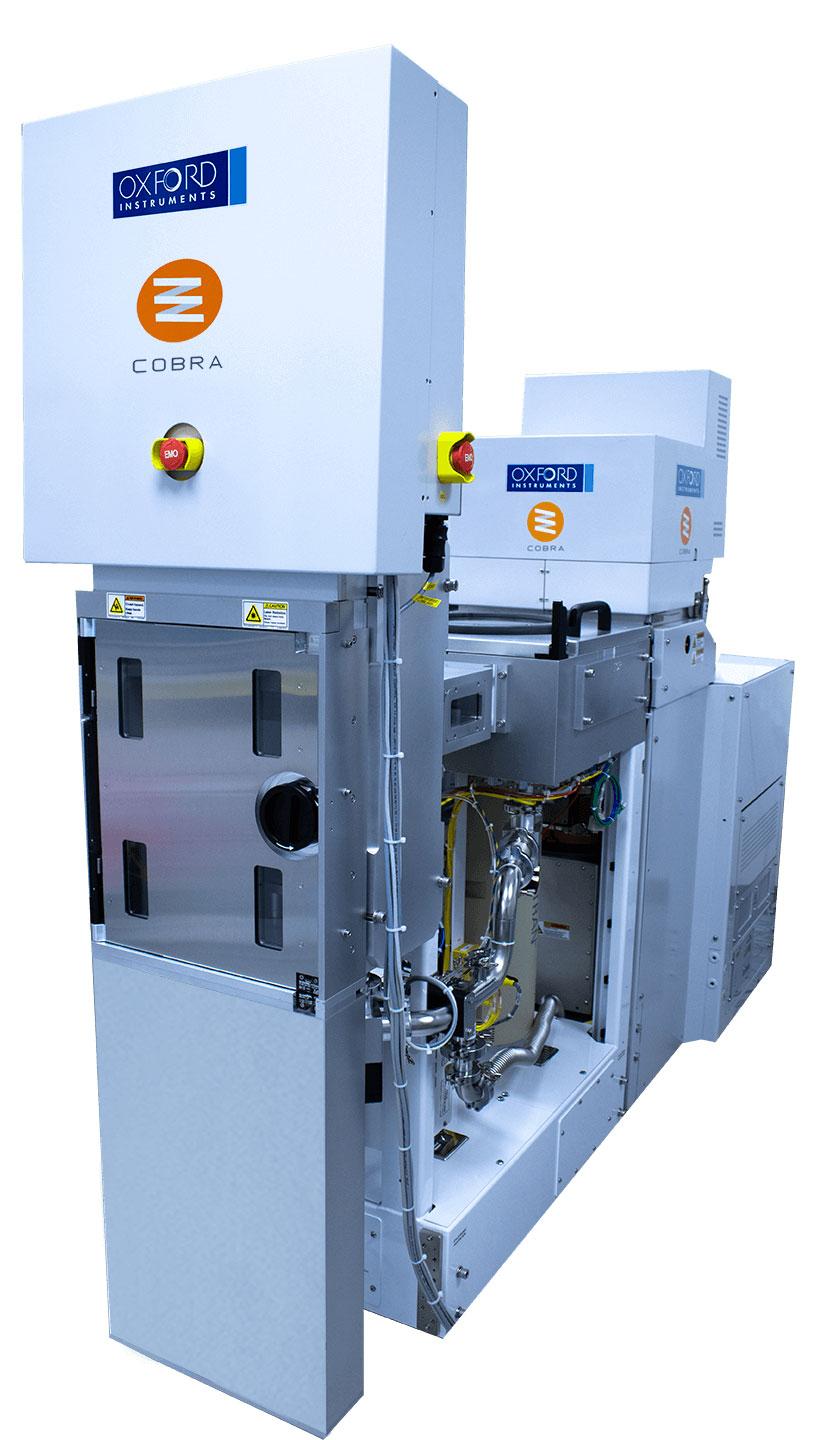Wednesday, November 29, 2023
Launch of the Oxford Instruments Innovation Centre: Advancing Scientific Research and Collaboration
Friday, November 24, 2023
Oxford Instruments Secures Major Orders for GaN ALE & ALD Systems from Leading Japanese Power Electronics and RF fabs
Oxford Instruments Plasma Technology staff at ALD2018/ALE2018 in Korea (Looking Back on ALD/ALE 2018 - Oxford Instruments (oxinst.com))
Monday, July 17, 2023
Oxford Instruments Reveals Advanced ALD Research System for Quantum Applications
“We have experienced high pre-launch interest from the market for the PlasmaPro ASP for superconducting quantum materials. The PlasmaPro ASP is designed to address key quantum challenges with an innovative high-rate source design and high machine up-time, as well as an intuitive software user interface called PTIQ."
“With the source design derived from our Atomfab® ALD production product, the PlasmaPro ASP retains process speed and robustness, with the inclusion of additional hardware to increase flexibility, which offers a unique solution to the quantum market to speed up development cycles.” Dr Russ Renzas, Quantum Technologies Market Manager, Oxford Instruments Plasma Technology, Americas.
The collaboration with Eindhoven University of Technology (TU/e) on the plasma source design yielded accolades, with their joint research paper receiving recognition at the American Vacuum Society’s 22nd International Conference on Atomic Layer Deposition (AVS ALD/ALE 2022) conference.
With a primary focus on quantum technology, the PlasmaPro ASP facilitates the creation of essential low-resistivity and high-Tc superconducting nitride films. The system's intuitive software interface, PTIQ, along with its adaptable source design from Oxford Instruments' Atomfab ALD production product, ensures both rapid processing and robustness.
Anticipation for the PlasmaPro ASP's launch, especially for its potential in superconducting quantum materials, underscores the imminent impact of this innovation. Collaborative efforts with TU/e will likely accelerate advancements in quantum technology and various applications like electronics and photonics.
Professor Erwin Kessels of TU/e praises the PlasmaPro ASP for its distinctive capabilities, set to invigorate diverse research and innovation prospects.
Breakthrough Ultra-fast ALD Product - Oxford Instruments (oxinst.com)
Monday, April 24, 2023
Oxford Instruments to supply KAUST with hardware upgrades and ALE systems
Significant partnership with KAUST: hardware upgrade and support its cutting-edge ALD research with the addition of ALE capability
Thursday, September 22, 2022
Oxford Instruments and ITRI report GaN HEMT device performance by ALD and ALE
GaN HEMT device performance - Oxford Instruments and ITRI announce breakthrough development in GaN HEMT device performance

Friday, September 2, 2022
Oxford Instruments validates Plasma Etch process as alternative to SiC CMP
Wednesday, December 1, 2021
Webinar RIE and ALE Processes for Quantum Devices
This webinar will give an introduction of:
- The various etch platforms that are available and their differences
- How each etch system can be used to overcome some of the processing roadblocks
- Quantum-specific examples of what can be done and why it should be done during device fabrication process
| |
|
Tuesday, November 9, 2021
Innovative remote plasma source for atomic layer deposition for GaN devices
Thursday, July 22, 2021
Wafer-level uniformity of atomic-layer-deposited niobium nitride thin films for quantum devices
Thursday, July 1, 2021
Tier 1 semiconductor automotive supplier selects Oxford Instruments Plasma Technology’s ALE technology for it’s GaN power electronic program
- Digital/Cyclical etch process – etching equivalent of ALD
- Low damage
- Smooth etch surface
- Superb etch depth control
- Ideal for nanoscale layer etching (e.g. 2D Materials)
- Wide range of processes and applications
Monday, April 6, 2020
White Paper: Atomic Layer Deposition for Quantum Devices
Conventional methods for depositing superconductors include sputtering, pulsed laser deposition (PLD), and chemical vapour deposition (CVD). However, these methods can suffer from drawbacks including a lack of thickness control, poor uniformity and high impurity content.
Atomic layer deposition (ALD) is much more beneficial for thin-film deposition due to its ability to produce films with high purity, precise thickness control, conformal coating in high aspect ratio structures, and uniformity over large-area substrates.
Thursday, June 27, 2019
Oxford Instruments launches Atomfab®: High volume ALD manufacturing solution for GaN power device passivation
One of the key challenges is a consistently high-quality gate passivation, Atomfab delivers this solution with high throughput and low Cost of Ownership (CoO).
- Performance: Excellent passivation and dielectric properties enable the demanding device performance critical for key applications.
- Plasma: Remote plasma delivers a reproducible GaN interface. Atomfab precisely controls the plasma to protect the underlying sensitive GaN substrate.
- Pace: High throughput delivered by a high deposition rate process on a high uptime HVM platform specifically developed for GaN power applications.
Atomfab fulfils the customer needs on a single wafer platform with SEMI standard cluster configurations and improved process controls for the latest compound semiconductor solutions.
“Atomfab provides many key benefits to our GaN device manufacturing customers including significant CoO reduction, increased yield and excellent film quality & device performance. For many years Oxford Instruments Plasma Technology has been known as the go to supplier for compound semiconductor plasma solutions. We’ve leveraged that knowledge onto a HVM platform to ensure optimum devices are produced all day, every day”, says Klaas Wisniewski, Strategic Business Development Director, OIPT.
Mike Gansser-Potts, Managing Director, OIPT states: “We’ve been highly commended for our unique plasma ALD solutions and have listened to our HVM customers to take these solutions to the next level. We are happy to announce that Atomfab provides these HVM solutions to our customers”.
Additional Information:
Whitepaper: "Atomic Layer Deposition and Atomic Layer Etching for GaN Power Electronics"(LINK)
Blog: "5 Ways ALD Can Benefit GaN Devices" (LINK).
Saturday, January 26, 2019
Oxford Instruments Partners ITRI for Micro LED Development with Plasma Etch Solutions

Friday, January 18, 2019
ULVAC Inc. and Oxford Instruments Plasma Technology collaborate to bring Atomic Scale Processing solutions to the Japanese Power and RF markets
“Oxford Instruments Plasma Technology is excited to be collaborating with ULVAC in order to bring its proven process solutions to the Japanese power and RF markets”, commented Mike Gansser-Potts, Managing Director, Oxford Instruments Plasma Technology. “This relationship, which will begin with ULVAC as our channel partner in Japan, will allow local production customers access to Oxford Instruments’ suite of Atomic Scale Processing solutions”
“This is indeed a very significant collaboration”, confirmed Tetsuya Shimada, General Manager for Advanced Electronics Equipment Division of ULVAC Inc., “Our new collaborator, Oxford Instruments Plasma Technology, has critical process technology and know-how which complements our own capabilities. Combined with our customer support infrastructure this will allow us to provide a complete solution to our Japanese customers.”
Oxford Instruments Plasma Technology’s Atomic Layer Deposition (ALD) and Atomic Layer Etch (ALE) are critical process steps for GaN and SiC based devices to enable functionality and reliable device manufacturing. With the critical know-how and expertise gained over the last ten years in Wide Band Gap applications, Oxford Instruments Plasma Technology is perfectly placed to serve the technology leading Japanese production customers in these markets.
Wednesday, December 19, 2018
The semi equipment market will contract 2019 but grow 20.7 percent to reach an all-time high 2020
Written by Abhishekkumar Thakur and Jonas Sundqvist
Saturday, December 15, 2018
Oxford Instruments participates in the EU Quantum Technology Flagship Programme (QMiCS)
QMiCs project partners:
- Walther-Meißner-Institute (WMI) for Low Temperature Research of the Bavarian Academy of Sciences and Humanities, Germany, Coordinator
- Aalto University (AALTO), Finland
- Ecole Normale Supérieure de Lyon (ENSL), France
- Instituto de Telecomunicações (IT), Portugal
- Oxford Instruments nanotechnology Ltd, United Kingdom
- TTI Norte S.L. (TTI), Spain
- University of the Basque Country (UPV/EHU), Spain
- VTT Technical Research Centre of Finland Ltd (VTT), Finland



%20(1).png)

.jpg)















